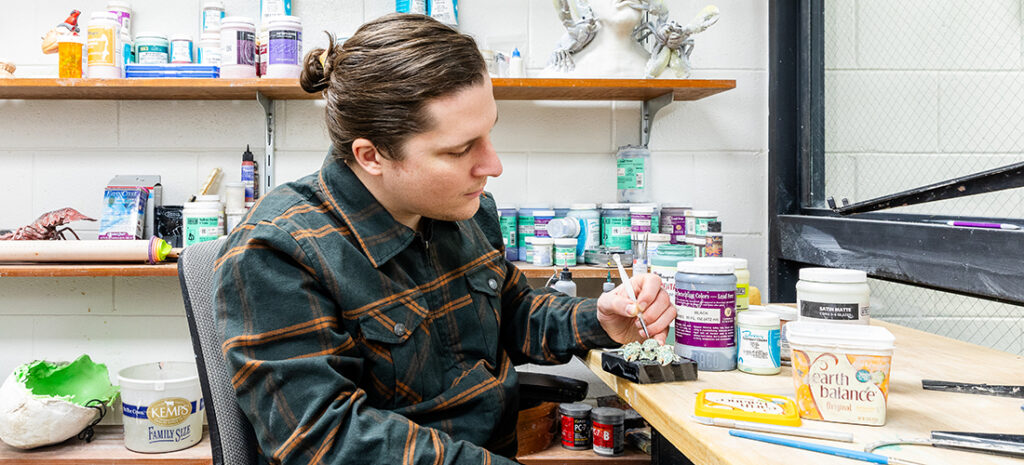Character Study

Portrait of an Artist
Getting the expression right
By Emilee Phillips
Wet hands glide across a lump of drab earth. They’re sticky and itching to go to work. It takes 2,200 degrees to transform clay into a sculpture, firing it into a form waiting to be finished, then seen.
The main studio is in the basement. Light coats of dust cover the floor, and buckets line the walls holding the raw materials of creativity. It’s utilitarian, not glamorous. The beauty lies in the fingertips of the artists.
Luke Huling, a professor of visual arts at Sandhills Community College, is always making something. Originally from Pennsylvania, Huling has moved wherever his jobs take him. He earned his Master of Fine Arts in ceramics from Indiana University, followed by residencies at the LUX Center for the Arts in Nebraska and the Arrowmont School of Arts and Crafts in Tennessee. He’s been teaching at Sandhills for three years.
“I feel like I’m never 100 percent complacent with what I’m doing, but I feel like that makes a good artist because it means you’re always working. Always creating,” says Huling, who spends 12 hours a day teaching, sculpting or grading his students.
Ceramic art involves first sculpting the work, and then finishing it with paint and glazing. “I love being in the moment — having the ability to change whatever I want,” says Huling. He’s made everything from tabletop-sized works to life-sized sculptures. Neither texture nor detail is overlooked. Each piece evolves as Huling labors over the tiniest area until he achieves his desired effect. He often creates in series where repetition forms the connective tissue, distinguishing each individual sculpture by its emotion. Depending on its size, a piece can take him up to a month to complete.
Fascinated by human psychology, Huling explores the “emotional façades” most people hide behind. Being authentic is something he strives for. He uses a mirror to get the micro details just right in the expressions he’s modeling. “Humans are complicated,” he says with a grin, not discounting himself.
While he laughs about it now, Huling admits his mother put him in art classes as a child because his brother was athletic and he wasn’t. “Art stuck with me,” he says. “That was what I was good at.”
Prior to pursuing a career in the arts, Huling studied dental hygiene and credits the experience with helping him portray facial anatomy in his work. That’s nothing new. Sculptors from Michelangelo to Rodin to the present day have relied on anatomical research in their art.
In his most recent work, “Molted Mindset,” you’ll see faces being pinched by lobsters and other crustaceans. He uses the sea creatures to convey that even in times of stress you’re growing. The stimulus for a lobster to grow is stress or pain. He leaves the analogy open for the viewer to interpret, with each sculpture having a slightly different facial expression.
Left & Middle: Molted Mindset IV. Stoneware, underglaze, glaze. 18 x15 x16 inches. (Photographs courtesy of Luke Huling)
Right: Molted Mindset III. Stoneware, underglaze, glaze. 18 x15 x16 inches. (Photograph courtesy of Luke Huling)
Walk into his studio at Sandhills Community College, and there’s a chance you’ll hear podcasts playing in the background. “I’m a figurative artist,” he says, “so any insight into other’s psyche is interesting to me.”
To find a measure of success in the art world, you have to be willing to go where the work is. Huling and his creations — along with 10 other ceramic artists — were recently featured in Indiana University’s Grunwald Gallery of Art in an exhibition called “Derivations.”
“The way the exhibition came together was lovely,” says Grunwald Gallery’s director, Linda Tien, adding that IU’s ceramics program is well known for its figurative work. “There was quite a range of ways the figure was represented in the gallery. Luke’s work added to the diversity.”
Some pieces can be heavy, both in the literal and metaphorical sense. Huling is known to flip the script when asked about his art.
“I usually ask people to tell me what they see first,” he says. “There’s no right or wrong answer in art. That’s the beauty of it, it doesn’t necessarily have to add up.” PS
Emilee Phillips is PineStraw’s director of social media and digital content.
